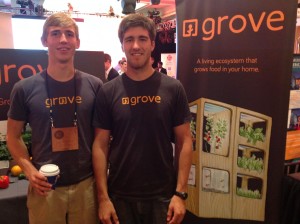First of all, I cannot even express how happy this organization makes me. Like, I can’t even.
Now that we’ve established my excitement, I can tell you about the actual organization. Julie Carney co-founded Gardens for Health in 2007 with her friend Emma Clippinger. The original idea was to work with people with HIV/AIDS in Rwanda to help them grow their own food for consumption and sale. However, after two years of living and working toward this goal in Rwanda, Julie realized that they were working on the wrong problem. Malnutrition was the bigger issue in Rwanda. So Gardens for Health developed accordingly. This is a fantastic example of reframing the problem and pivoting in your idea to address the problem more effectively and be more successful in your entrepreneurial endeavors.
Now Gardens for Health fights malnutrition in Rwanda by “partnering with local health centers to integrate agricultural support and comprehensive health education into the clinical treatment of malnutrition.” They work to include agriculture training for local families in the usual assistance provided by public health centers.
“Our agriculture team works to blend international innovations in sustainable agriculture with time-tested Rwandan farming practices in order to help every family with whom we work to make the most of their existing resources.
Through our work, we are changing the way that malnutrition is treated by moving away from short-term handouts and towards equipping families with the knowledge and resources to grow their own nutritious food and improve their health. We envision a future in which the key to lasting food and nutrient security for vulnerable families lies in their own backyards.”
Again, I LOVE the mission of this organization!!! This is innovation the world needs! Find out more about Gardens for Health at their website.
 Curt Bowen grew up on a small organic farm in Idaho, so he knows a thing or two about agriculture and social engagement. His first service experience in Central America was building a house for a widowed family in Nicaragua as a teenager. During this trip he realized that it was impossible to help everyone in the same way, and that the root causes of poverty need to be examined rather than simply attempting to alleviate its symptoms.
Curt Bowen grew up on a small organic farm in Idaho, so he knows a thing or two about agriculture and social engagement. His first service experience in Central America was building a house for a widowed family in Nicaragua as a teenager. During this trip he realized that it was impossible to help everyone in the same way, and that the root causes of poverty need to be examined rather than simply attempting to alleviate its symptoms. example of the progress Semilla Nueva has made is pigeonpea. “Pigeonpea is a drought resistant bean bred to grow simultaneously with corn and other crops. It cuts fertilizer costs by fixing organic nitrogen, decreases soil compaction, provides high protein and nutrient rich food, and is open-pollinated, allowing farmers to save their own seed.” Simply giving farmers access to this seed can increase the health of the farmers’ soil, provide more nutritious food, and increase farmers’ incomes.
example of the progress Semilla Nueva has made is pigeonpea. “Pigeonpea is a drought resistant bean bred to grow simultaneously with corn and other crops. It cuts fertilizer costs by fixing organic nitrogen, decreases soil compaction, provides high protein and nutrient rich food, and is open-pollinated, allowing farmers to save their own seed.” Simply giving farmers access to this seed can increase the health of the farmers’ soil, provide more nutritious food, and increase farmers’ incomes.



 In addition to creating a soil enhancer, sustainable biochar practices can produce oil and gas byproducts that can be used as fuel, providing clean, renewable energy. When the biochar is buried in the ground as a soil enhancer, the system can become “carbon negative.”
In addition to creating a soil enhancer, sustainable biochar practices can produce oil and gas byproducts that can be used as fuel, providing clean, renewable energy. When the biochar is buried in the ground as a soil enhancer, the system can become “carbon negative.” et go he believed global poverty and climate change were the two biggest problems faced by the world. Biocher is the product that he came up with, and has essentially killed two birds with one stone.
et go he believed global poverty and climate change were the two biggest problems faced by the world. Biocher is the product that he came up with, and has essentially killed two birds with one stone.